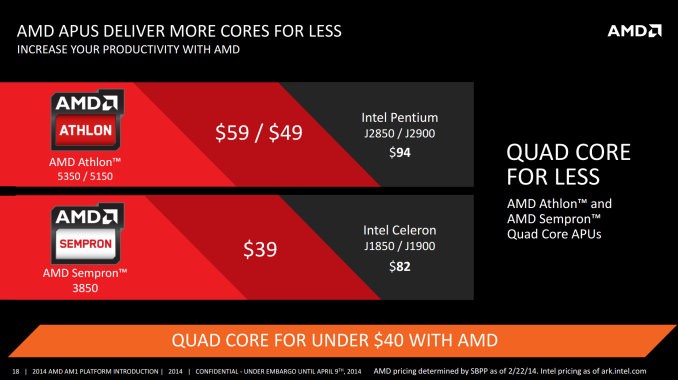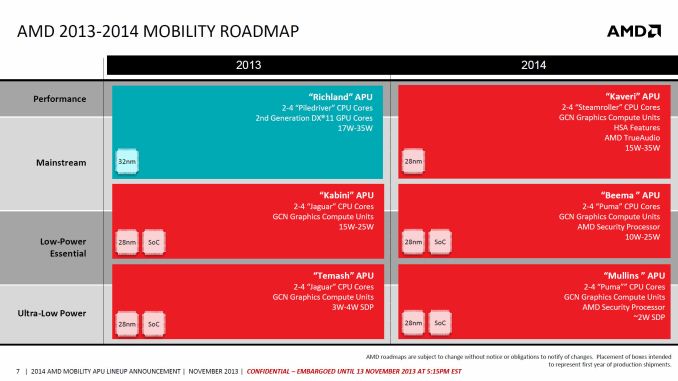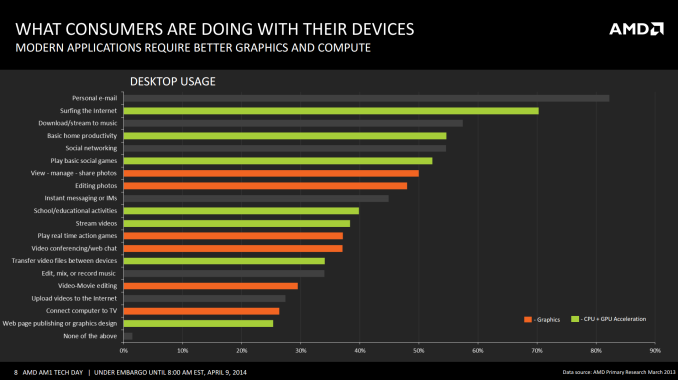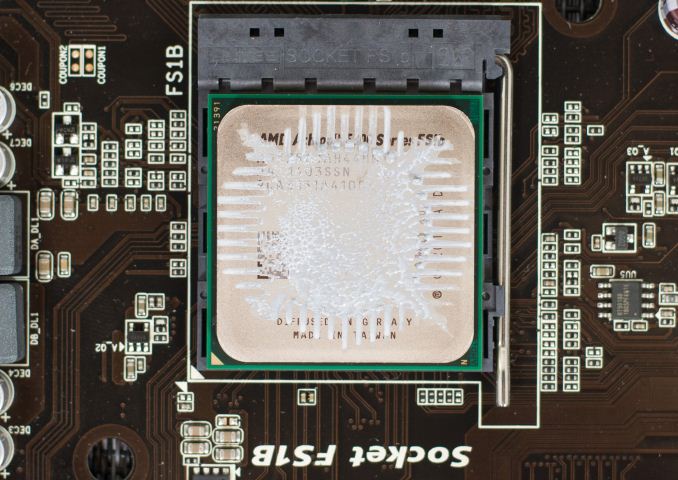The Desktop Kabini Review Part 1: AMD Athlon 5350 (AM1) Tested
by Ian Cutress on April 9, 2014 8:00 AM ESTFinal Words
As mentioned in our test setup, the benchmark results in this preliminary article are only a small fraction of our normal coverage. Due to other commitments we were unable to run every test on all comparison systems, but we have the other Athlon and Sempron APUs as well as comparable Intel counterparts coming in for review.
The poignant place to start with the final analysis is AMD’s claim of ‘Quad Core for Less’. In this statement alone, they are not wrong. Intel cannot provide a socketed quad core processor for less than $36 (Sempron 3850). The cheapest all-in-one desktop quad-core system from Intel equips the Celeron J1900 onto a motherboard for $92, which is exactly where AMD sit with the top-end Kabini based Athlon 5350 with a motherboard. One of the issues to consider at this point however is that Intel offers several dual core options (non-Atom) around this $40-$60 price point, and in many cases the IPC and CPU speed advantage of these cores is greater than that provided by Kabini, particularly in single threaded applications. The only downsides to this solution are the power consumption is higher, and the motherboards are more expensive. For a competitive socketed Intel dual core, a motherboard plus CPU can be in the region of $110-$120 at 35W-55W.
The big upside and selling point from the AM1 Kabini platform should be upgradeability. If a user buys an AM1 platform now, they should be able to upgrade it in the future. While AMD has not yet confirmed if Beema is coming to the socketed platform, the roadmaps suggest that the laptop sockets are remaining consistent from Kabini to Beema. This should imply that if Beema gets a socketed version, it should also remain based on AM1/FS1b.
If we compare single threaded performance between Kabini and our J1800 test system, the benchmarks are almost even between the two, particularly when it comes to synthetics such as Cinebench, but falls behind on emulation such as the Dolphin Benchmark and 3DPM. The integrated graphics of the Kabini pull ahead when it comes to gaming, despite the single channel memory interface.
|
AMD Athlon 5350 vs. Intel Celeron J1800 Single Threaded |
||
| Athlon 5350 | Celeron J1800 | |
| Cinebench R10 | 1967 | 1917 |
| Cinebench R11.5 | 0.51 | 0.49 |
| Dolphin Benchmark | 40.4 | 38.02 |
| 3DPM | 53.29 | 69.20 |
When placing Kabini against any Intel Ivy Bridge socketed processor, the increased IPC and frequency pushes the system above the Kabini, in exchange for more power and a more expensive system overall. If we compare the Kabini single-threaded results to those of the Celeron G465, a Sandy Bridge based single core CPU at 1.9 GHz, the Celeron does pull ahead on the majority, but fails miserably in the graphical benchmark suite.
|
AMD Athlon 5350 vs. Intel Celeron G465 Single Threaded |
||
| Athlon 5350 | Celeron G465 | |
| Cinebench R10 | 1967 | 2975 |
| Cinebench R11.5 | 0.51 | 0.73 |
| Dolphin Benchmark | 40.4 | 38.8 |
| 3DPM | 53.29 | 59.98 |
Does it seem particularly odd that a modern Kabini architecture at 2 GHz cannot keep up with a 3 year old Sandy Bridge processor at 1.9 GHz at our simple benchmarks? AMD is leveraging on the fact that much of what we do on a computer as a casual user can leverage the fixed function units of the graphics center of the APU:
AMD’s key in all of this is leveraging the GPU. For non-GPU intensive tasks, on paper, the J1900 for $92 and 10W TDP would seem to be the choice if upgradability is not a concern. The remit of AM1 and Kabini could be extended if motherboard manufacturers decided to use those extra PCIe lanes. Consider an AM1 with controllers to make a nice routing system (4x NIC) or something based around storage (SATA controllers and hubs). But because Kabini is also a cost play for AMD at the low-end desktop segment, margins are going to be ultra-tight for motherboard manufacturers and I do not imagine that as much effort will be put into making innovative products as the rest of their product range on other sockets.
In order for the upgradability angle to work, AMD need to keep the sockets around for at least two generations. AM1 comes late in Kabini’s life cycle, given that Beema on the mobile side is due out later in 2014. It would make sense for AMD to release Beema desktop parts, but the big question there is when. AMD could launch new processors on day 1 of Beema, or further into the life cycle. I would imagine that depends on what the competition does. AMD does have that advantage of having an upgradeable platform before Intel; however Intel may see the market differently. It is a hard one to judge.
Stay tuned for our full benchmark suite on the other AMD Kabini APUs.














126 Comments
View All Comments
kyuu - Wednesday, April 9, 2014 - link
Yeah I was going to say something about that. The article text and the graphs are not in agreement.kallogan - Wednesday, April 9, 2014 - link
ground breaking new tech ! Wow !Alexey291 - Thursday, April 10, 2014 - link
wowsuch tech
much ground breaking
wow
evonitzer - Wednesday, April 9, 2014 - link
In addition to what you are already planning to test, I would like to see some of the low end A4 or A6 APU's tested. They seem to be a blank spot for your reviews, making it tough to compare the cheap stuff against the previous generation. The A4's come with the same 2 CU GPU, but presumably better cpu performance, and are available pretty close to $50. Sure, they are higher TDP, but whatev.Anyway, interesting review. I'd be seriously tempted if I didn't just put together a cheap PC for my brother already. Maybe grandma can get a surprise upgrade ...
evonitzer - Wednesday, April 9, 2014 - link
Oh hold on, there aren't any A4's or A6's available in Kaveri form, which means no GCN to be had for cheap. That's interesting. I wonder how much difference it makes on the low end. Well either way, the A4-6300 (and below) are still interesting to compare.Glory2God - Wednesday, April 9, 2014 - link
That Atom C2750 looks awesome in the multi threaded benchmarks.rogueninja - Wednesday, April 9, 2014 - link
AMD dualcore, quadcore, octacore, 100 cores. Who give a damn. They're as fast as a turtle.Nintendo Maniac 64 - Wednesday, April 9, 2014 - link
Would have been nice if there were more older CPUs to compare to, like Athlon 64 x2, first gen Phenom X4, and Conroe Core 2 Duo (rather than Wolfdale). It'd be even better if said older CPUs were around 2.0-2.5GHz as wellsaiki4116 - Wednesday, April 9, 2014 - link
Please add comparison with A4-4000(40 USD) and A4-6300,they could cost 10-20usd more than kabini.BushLin - Wednesday, April 9, 2014 - link
Anandtech, where's the power consumption figures? Just quoting the 25w TDP feeds assumptions such as the one I'm replying to.Why is it every time AMD have a CPU worth buying (doesn't happen that often) you guys manage to totally miss the point in the review? It's enough to make an objective person sound like a fanboy.
I'll save you the trouble:
http://www.tomshardware.com/reviews/athlon-5350-am...
Although making the typical reviewer mistake of using a very high wattage PSU on a low power system, we can at least see something close to parity between an Athlon 5350 and a Celeron J1900 (the very same CPUs you reviewed).
Makes quite a different outcome doesn't it?